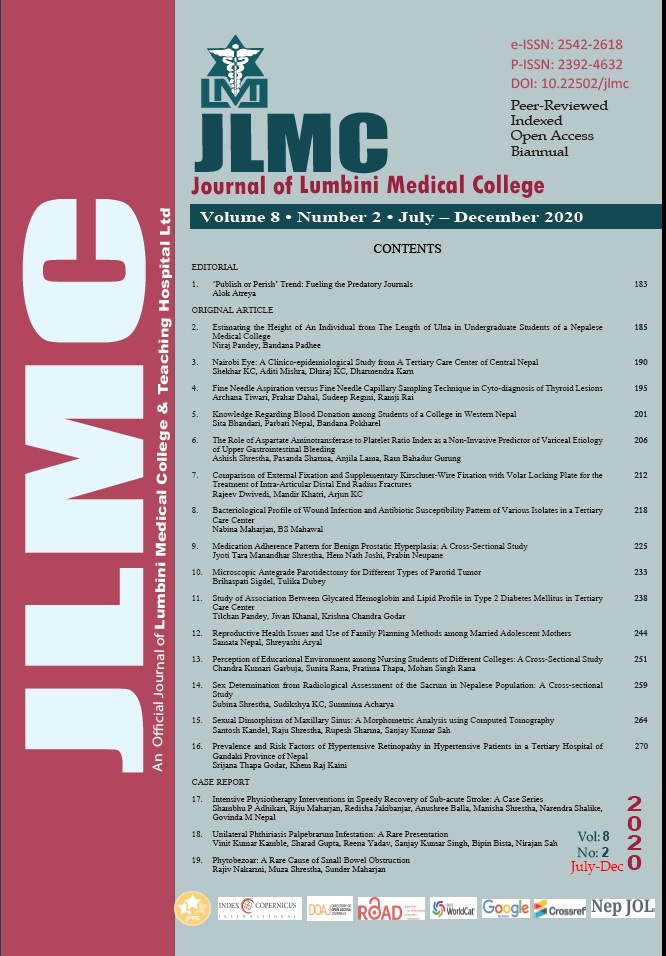Nairobi Eye: A Clinico-epidemiological Study from A Tertiary Care Center of Central Nepal
Keywords:
Dermatology, Nairobi Eye, Paederus dermatitis, PederinAbstract
Introduction: Periocular paederus dermatitis (Nairobi eye) is characterized by erythematous vesiculo-bullous linear plaque with stinging sensation. It commonly occurs during rainy season. It has been described in people living near agricultural fields due to the potential toxin pederin. This study aims to evaluate the demographic profile and clinical presentation of patients with periocular paederus dermatitis in a tertiary care center.
Methods: This was a descriptive, cross-sectional study evaluating patients attending dermatology and/or ophthalmology department with features consistent with paederus dermatitis involving periocular area from June to August, 2019. Relevant demographic and clinical data were obtained; clinical photographs were taken and histopathology performed among selected patients.
Results: A total of 24 (14.8%) patients had features of Nairobi eye among 162 patients of paederus dermatitis. Majority of the patients were males (1.4:1) with mean age 29.08±13.38 years. The peak time of presentation was the first week of July (37.5%). Mean time period between onset of symptoms and presentation was 3.41±2.01 days. The lesions were unilateral in all cases, with predominant involvement of the right eye (62%). Burning sensation (80%) and itching (60%) were the predominant symptoms while conjunctival hyperemia (41.6%), seropurulent discharge (20.8%) and chemosis (16.6%) were the ocular findings. Most of the patients (n=17, 70.8%) noticed the lesion while waking up in the morning.
Conclusion: The finding of the present study has shown that Nairobi eye is a common presentation during rainy season. Periocular findings with significant intraocular signs were documented to be presenting features among patients with periocular paederus dermatitis.
Downloads
Downloads
Published
How to Cite
Issue
Section
License
Copyright (c) 2020 Shekhar KC, Aditi Mishra, Dhiraj KC, Dharmendra Kan

This work is licensed under a Creative Commons Attribution 4.0 International License.
The Journal of Lumbini Medical College (JLMC) publishes open access articles under the terms of the Creative Commons Attribution(CC BY) License which permits use, distribution and reproduction in any medium, provided the original work is properly cited.JLMC requires an exclusive licence allowing to publish the article in print and online.
The corresponding author should read and agree to the following statement before submission of the manuscript for publication,
License agreement
In submitting an article to Journal of Lumbini Medical College (JLMC) I certify that:
- I am authorized by my co-authors to enter into these arrangements.
- I warrant, on behalf of myself and my co-authors, that:
- the article is original, has not been formally published in any other peer-reviewed journal, is not under consideration by any other journal and does not infringe any existing copyright or any other third party rights;
- I am/we are the sole author(s) of the article and have full authority to enter into this agreement and in granting rights to JLMC are not in breach of any other obligation;
- the article contains nothing that is unlawful, libellous, or which would, if published, constitute a breach of contract or of confidence or of commitment given to secrecy;
- I/we have taken due care to ensure the integrity of the article. To my/our - and currently accepted scientific - knowledge all statements contained in it purporting to be facts are true and any formula or instruction contained in the article will not, if followed accurately, cause any injury, illness or damage to the user.
- I, and all co-authors, agree that the article, if editorially accepted for publication, shall be licensed under the Creative Commons Attribution License 4.0. If the law requires that the article be published in the public domain, I/we will notify JLMC at the time of submission, and in such cases the article shall be released under the Creative Commons 1.0 Public Domain Dedication waiver. For the avoidance of doubt it is stated that sections 1 and 2 of this license agreement shall apply and prevail regardless of whether the article is published under Creative Commons Attribution License 4.0 or the Creative Commons 1.0 Public Domain Dedication waiver.
- I, and all co-authors, agree that, if the article is editorially accepted for publication in JLMC, data included in the article shall be made available under the Creative Commons 1.0 Public Domain Dedication waiver, unless otherwise stated. For the avoidance of doubt it is stated that sections 1, 2, and 3 of this license agreement shall apply and prevail.
Please visit Creative Commons web page for details of the terms.




